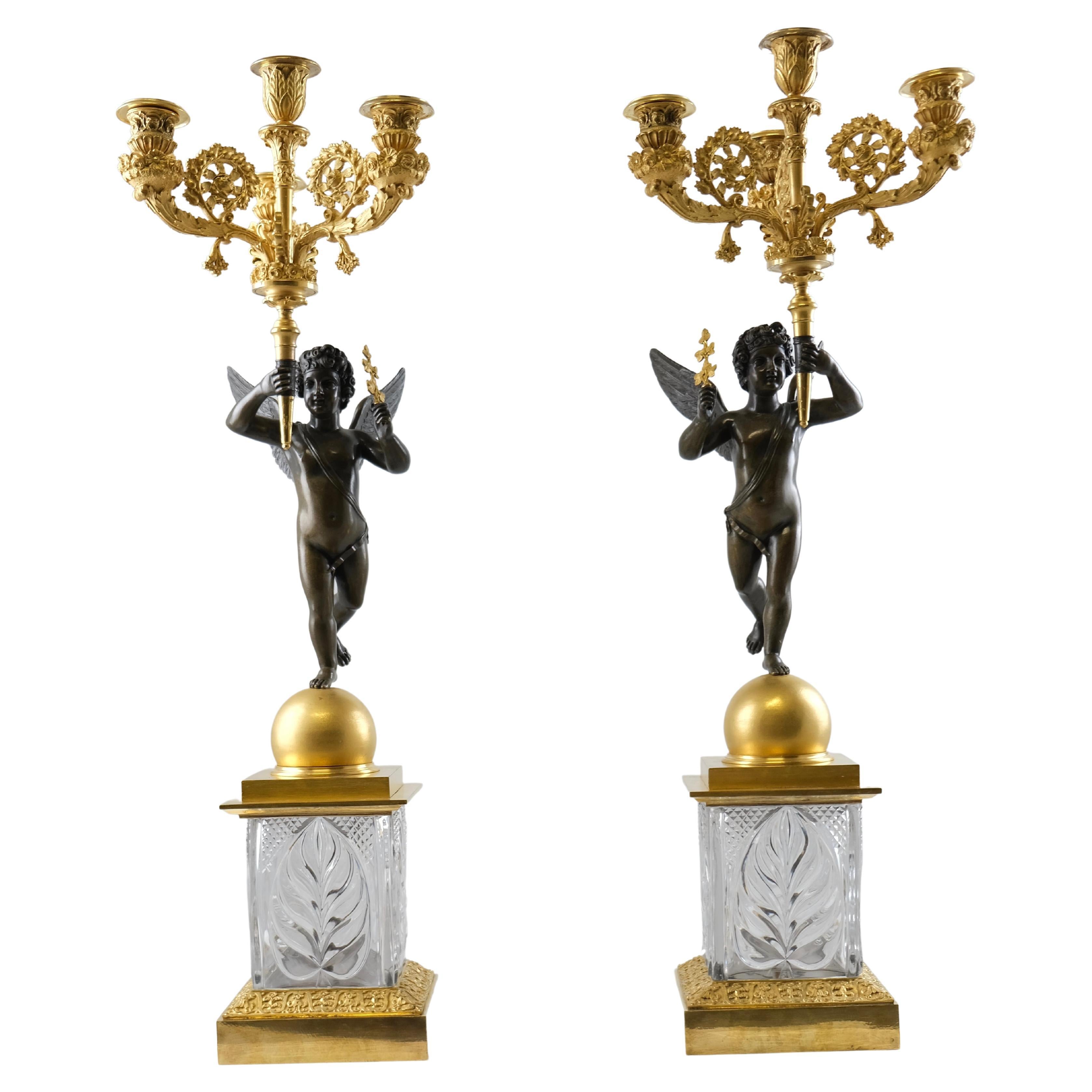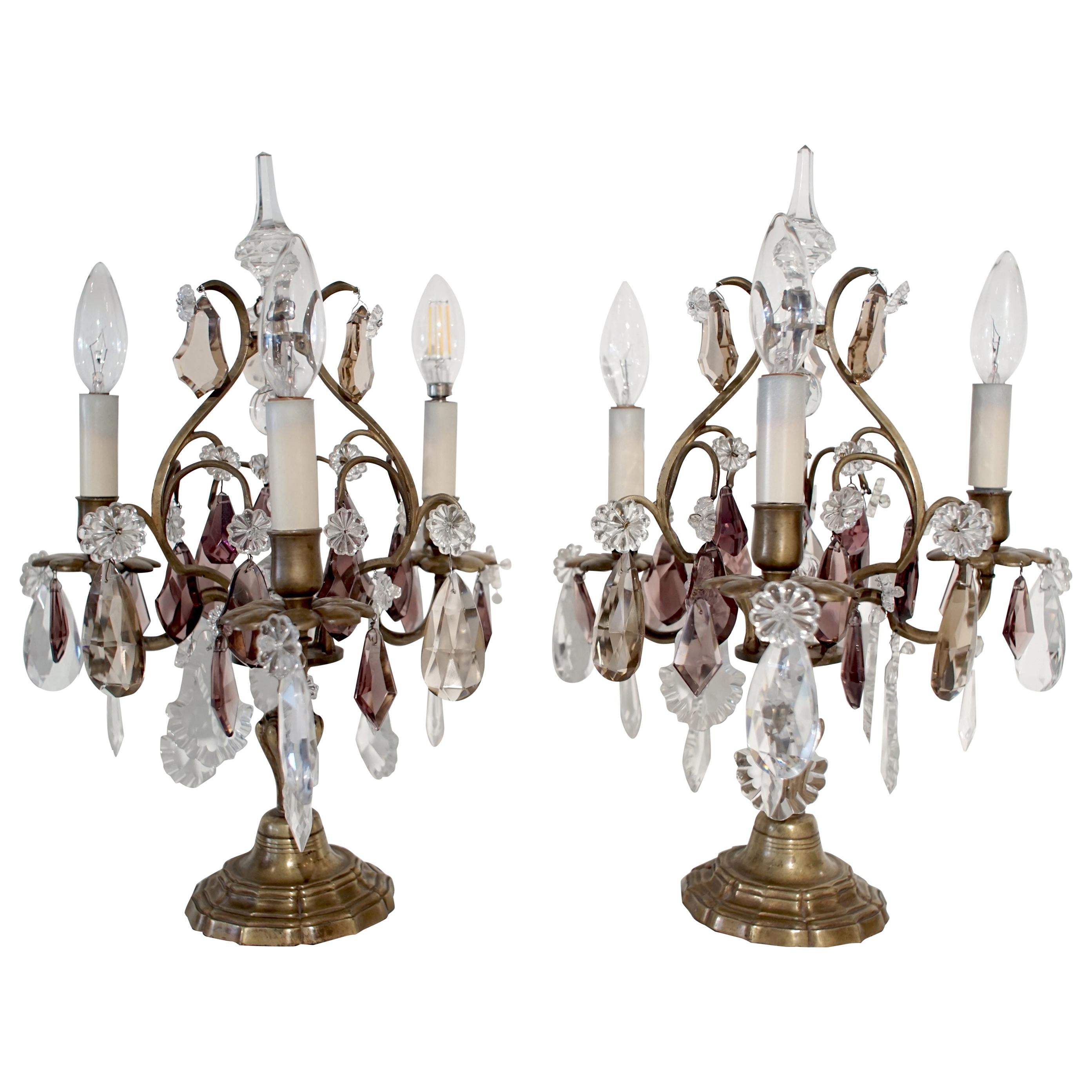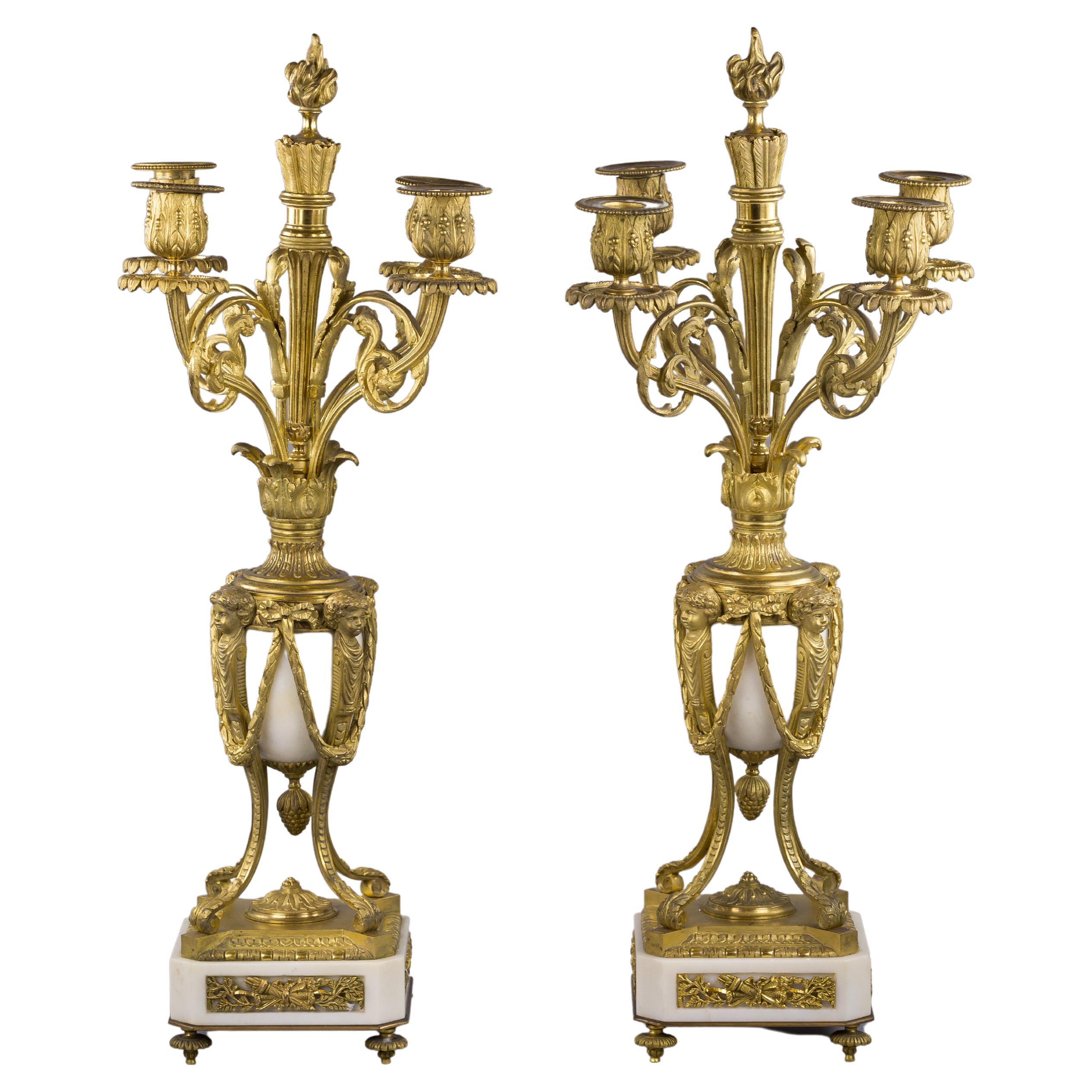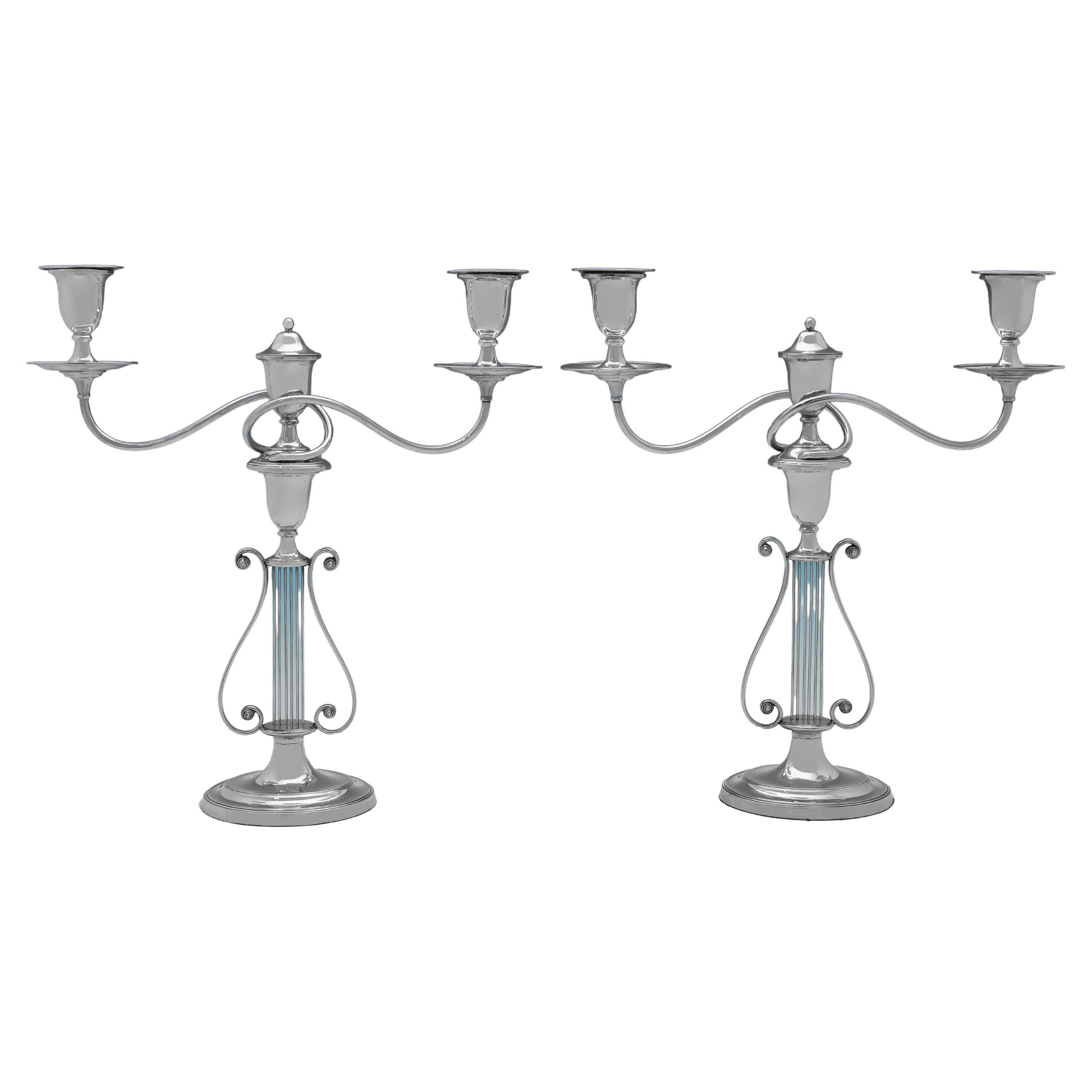Items Similar to Pair of French Three-Flame Candelabra Candelabra, circa 1860
Video Loading
Want more images or videos?
Request additional images or videos from the seller
1 of 19
Pair of French Three-Flame Candelabra Candelabra, circa 1860
About the Item
Pair of three-flame candelabra
Cast bronze, chiselled and mercury gilded
France, third quarter of the nineteenth century
Height 14.96 in (38 cm) X 12.59 (32 cm)
Weight 11.46 lb (5.2 kg) each
State of conservation: very good
The two candelabra were made out of several elements of melted bronze, chiselled and then mercury gilded. The parts were later assembled to form the refined “flambeaux” with a sinuous articulated shape.
The hollow base has a shaped vertical edge that alternates curves with square plinths. The alternation of the geometric elements is repeated on the foot and stem in elegant chiselled ornaments. The ornamentation reflects a large part of the decorative repertoire of the time: frets, double hollow embossed, protruding frames and hollow gorges; festoons in relief around curled column capitals; continuous spiral creases with small spheres in the center.
In the upper portion the chalice is enriched with engraved lance-shaped leaflets and the arms branch off from double circlets of petals that surround a central cuspidate element ending in a closed bud filled with small spherical fruits. These are reproduced, in more minute forms, as an embellishment to the linear strokes as well as at the base of the bobèches.
The arms have a shape in keeping with the alternating curved and straight lines and widen around the stem. These terminate in elegant bobèches supported by a truncated cone element, which in turn holds the cylindrical candle-holder decorated with lance-shaped leaves alternating with sunken ashlar motifs.
The excellent gilding technique and the sophisticated decorative style with classical ornamental embellishments confirm that the two candelabra were produced in Paris for a high commission during the period of the Second Empire (1848-1870).
- Dimensions:Height: 14.97 in (38 cm)Diameter: 12.6 in (32 cm)
- Sold As:Set of 2
- Style:Napoleon III (Of the Period)
- Materials and Techniques:
- Place of Origin:
- Period:
- Date of Manufacture:Circa 1860
- Condition:Minor fading.
- Seller Location:Milano, IT
- Reference Number:1stDibs: LU4352214861412
About the Seller
4.3
Vetted Seller
These experienced sellers undergo a comprehensive evaluation by our team of in-house experts.
Established in 1860
1stDibs seller since 2018
19 sales on 1stDibs
Typical response time: 6 hours
Associations
International Confederation of Art and Antique Dealers' Associations
- ShippingRetrieving quote...Ships From: Milano, Italy
- Return PolicyA return for this item may be initiated within 14 days of delivery.
More From This SellerView All
- 19th Century Pair of French or Russian Gilt Bronze Candelabra, circa 1830Located in Milano, ITPair of thirteen-flame candelabra France or Russia Second quarter of 19th century Cast, chiseled and gilt bronze Height 40.95 in (cm 104), diameter 17,7 in (cm 45) 97 lb (44 kg) Sta...Category
Antique 1830s French Neoclassical Candelabras
MaterialsOrmolu
- German Globe by C. Abel-Klinger, Nuremberg, circa 1860By C. Abel-KlingerLocated in Milano, ITTerrestrial globe Artistic company C. Abel - Klinger Nuremberg, circa 1860 H cm 31 x 22 cm (12.20 x 8.66 in); sphere 14 cm (5.51 in) in diameter lb 2.30 (kg 1.04) State of conservation: good. On the sphere there are slight visible signs of accidental bumping at the poles, as well as on New Guinea and England (vertical and more visible); some ink stains, especially at the South Pole and on the meridian that crosses North America. The globe is composed of twelve whole gores of printed paper, juxtaposed and glued on a sphere made with a chalky base mixture. The circle of the meridian, made of brass...Category
Antique 1860s German Other Scientific Instruments
MaterialsWood, Paper
- Italian Ancient Botticino Marble Pair of Pinnacles, circa 1850Located in Milano, ITPair of pinnacles Northern Italy, mid-19th century Botticino marble, carved They measure 33.1 inches in height x 17.7 x 17.7 (84 cm x 45 x 45) State of conservation: some visible cracks and various small gaps. The two twin architectural elements of sculpted Botticino marble have a quadrangular base from which a chalice-shaped foot extends. Resting on this, a round pod-like element swells up to support a large pine cone. This is the main decoration: however, the other ornamental details enhance and embellish it, while exalting its position above, whether observed from afar or up close. These aesthetic characteristics suggest that originally the pair of pinnacles were placed on columns or on architectural plinths...Category
Antique 1850s Italian Other Architectural Elements
MaterialsMarble
- Two Pairs of Italian Maiolica Baskets, circa 1780By Antonio FerrettiLocated in Milano, ITTwo pairs of maiolica baskets Antonio Ferretti Manufacture Lodi, circa 1770-1790 Maiolica polychrome decorated “a piccolo fuoco” (third fire). Measures: A) Height 3.54 x 6.69 x 9.84 in (9 x 17 x 25 cm); B) Height 3.93 x 7.48 x 11.02 in (10 x 19 x 28 cm). Total weight 4.85 lb (2.200 kg) State of conservation: A) One of the smaller baskets has some areas of restoration, the other slight chipping from use; B) One of the larger baskets is intact and the other shows a clearly glued break. The mold with which the baskets were forged simulates a wicker weave. The two larger works have high, vertical walls, with branch-shaped handles penetrating the weave. The painted decorations, small polychrome flowers applied only externally, highlight the points where the weaves intersect. The decision to leave the center of the basket devoid of decoration is highly unusual, but given the size and complexity of the shape, as well as the quality of the enamel, it is possible to hypothesize that it represents a precise choice in manufacturing or for a particular client. The two smaller baskets have small, twisted handles and, on the outside, reproduce more decisively the characteristic wicker weave, obtained through thin molded lines. The interior exhibits a rich, typical decoration of naturalistic flowers: a bunch centered around a main flower and secondary stems accompanied by small “semis”. The exterior of these works is also adorned with small little flowers where the weaves intersect. The size and morphological characteristics of the baskets confirm their attribution to the Lodi factory of Antonio Ferretti between 1770 and 1790, during its most successful period; by this point his original reworking of the "Strasbourg" decoration, known as "old Lodi", had achieved great fame even outside Italy. This decorative choice represented a strong point of the Lodi factory, which established itself thanks to the vivid nature of the colors made possible by the introduction of a new technique perfected by Paul Hannong in Strasbourg and which Antonio Ferretti introduced in Italy. This production process, called “piccolo fuoco” (third fire), allowed the use of a greater number of colors than in the past; in particular, the purple of Cassius, a red made from gold chloride, was introduced. Its use allowed for many more tones and shades, from pink to purple. The Ferretti family had started their maiolica manufacturing business in Lodi in 1725. The forefather Simpliciano had started the business by purchasing an ancient furnace in 1725 and, indeed, we have evidence of the full activity of the furnaces from April of the same year (Novasconi-Ferrari-Corvi, 1964, p. 26 n. 4). Simpliciano had started a production of excellence also thanks to the ownership of clay quarries in Stradella, not far from Pavia. The production was so successful that in 1726 a decree of the Turin Chamber came to prohibit the importation of foreign ceramics, especially from Lodi, to protect internal production (G. Lise, La ceramica a Lodi, Lodi 1981, p. 59). In its initial stages, the manufacture produced maolicas painted with the “a gran fuoco” (double fire) technique, often in turquoise monochrome, with ornamentation derived from compositional modules in vogue in Rouen in France. This was also thanks to the collaboration of painters like Giorgio Giacinto Rossetti, who placed his name on the best specimens next to the initials of the factory. In 1748 Simpliciano made his will (Gelmini, 1995, p. 30) appointing his son Giuseppe Antonio (known as Antonio) as universal heir. After 1750, when Simpliciano passed away, Antonio was directly involved in the maiolica factory, increasing its fortunes and achieving a reputation on a European level. Particularly important was the aforementioned introduction in 1760 of the innovative “a piccolo fuoco” (third fire) processing, which, expanding the ornamental repertoire with Saxon-inspired floral themes, could commercially compete with the German porcelains that had one of its most renowned offerings in the naturalistic Deutsche Blumen. Antonio Ferretti understood and promoted this technique and this decoration, proposing it in a fresher and more corrective version, less linked to botanical tables...Category
Antique 1770s Italian Neoclassical Ceramics
MaterialsMaiolica
- Ancient Italian Pair of Armchairs in “Petit Point” Embroidery, Turin Circa 1750Located in Milano, ITPair of carved walnut armchairs covered in “petit point” embroidery Turin, circa 1750 They measure 33.8 in (86 cm) in height; 17.32 in (44 cm) in height to the seat; 25.98 in (66 cm...Category
Antique Mid-18th Century Italian Rococo Armchairs
MaterialsWool, Walnut
- Ancient Pair of Italian Maiolica Dishes Milano, circa 1770By Felice ClericiLocated in Milano, ITTwo maiolica dishes, "Famille Rose" decoration Felice Clerici Factory Milan, 1770-1780 9.13 in (23.2 cm) each in diameter lb 1.32 (kg 0.6) State of conservation: perfect, except for...Category
Antique 1770s Italian Rococo Ceramics
MaterialsMaiolica
You May Also Like
- Pair of Large Oryx Horn Three-Arm CandelabraLocated in Palm Beach, FLA pair of large oryx horn three-arm candelabra, with silvered adjustable arms, tips and bases, all on ebonized turned wood bases.Category
Vintage 1960s French Organic Modern Candle Holders
MaterialsHorn
- Pair of French Empire Candelabra, ca 1820Located in Stockholm, SEThese pair of candelabra are very unusual with the cut crystal bases. Glass was one of the most expensive materials in these times and therefore exc...Category
Antique Early 19th Century French Empire Candelabras
MaterialsBronze
- French Pair of Louis XV Style Bronze Girandoles Crystal CandelabrasLocated in Montreal, QuebecFrench pair of bronze girandoles candelabras with clear and amethyst crystals. Rare beautiful pair. Dimensions: 17.5” H x 12” D Base 5” D.Category
Early 20th Century French Louis XV Candelabras
MaterialsCrystal, Bronze
- French Pair of Bronze Girandoles Candelabras with Clear and Amethyst CrystalsLocated in Montreal, QuebecFrench pair of bronze girandoles candelabras with clear and amethyst crystals. Rare beautiful pair. Dimensions: 17.5” H x 12” W x 12” D Base diameter 5”.Category
Early 20th Century French Louis XV Candelabras
MaterialsCrystal, Bronze
- Pair of French Bronze and Marble Candelabras, circa 1860Located in New York, NYPair of French bronze and marble candelabras, circa 1860.Category
Antique 1860s French Candelabras
MaterialsMarble, Bronze
- Pair of Victorian Antique Silver Plated 'Lyre' Candelabra, Made circa 1880Located in London, LondonMade in London circa 1880, this charming pair of Antique, Silver Plated Candelabra, are in the 'Lyre' design, with each holding 2 candles. Each candelabrum measures 17.75"(45cm) ...Category
Antique 1880s English Victorian Candelabras
MaterialsSilver Plate
Recently Viewed
View AllMore Ways To Browse
Gilded French
Bronze Of Napoleon
Pair Bronze Frames
Circa 1860 Bronze
Large Gilded Frame
Napoleon Small
Mercury Bronze
Napoleon French Empire
Gilded Napoleon
Decorative Bobeches
Bronze Of Mercury
Circa Gold Candelabras
Period Candelabra
Small Candelabra
Pair Of Gilded Frames
Pair Napoleon Bronze
Curved Candle
Large Pair Candelabra





